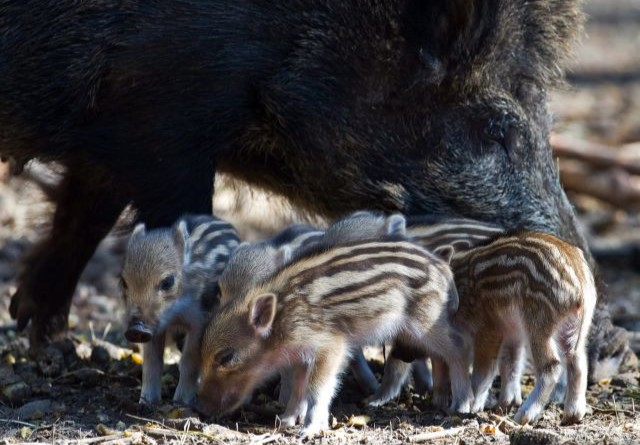
The last time Europeans were informed about the closest nuclear threat to Europe, it was about the fate of the Zaporizhzhya plant, due to the Russian-Ukrainian war. But now scientists have discovered radioactivity in the heart of Europe.
In recent research, a group of German scientists from Leibniz University of Hannover and the Vienna University of Technology came to a very strange, if not alarming, result.
The study was published in the journal Environmental science and technologyHigh levels of radiation have been found in the tissues of wild boars in the mountains of Bavaria.
Overall, “we have no indication that wild boar meat in Germany is contaminated with significant radioactivity,” Torsten Reinwald, a spokesman for the German Hunting Association, said in an interview.
However, the new results were so unexpected that when George Steinhauser, the head of the research, and his colleague first saw the results, they thought something was wrong. “This can’t be right, this isn’t possible,” Professor Steinhauser recalls his colleague saying.
The solution to the mystery
Scientists have long known that plants and animals in Central Europe still bear traces of radioactivity from the 1986 Chernobyl nuclear power plant accident.
Because radiation from the accident temporarily contaminated large areas of Ukraine, Belarus, Russia and Central Europe, plants and animals are regularly tested to see if they are safe for human consumption.
However, these strong traces of radioactivity in wild rhinos, according to the researchers, come from atmospheric nuclear weapons tests that took place long before the Chernobyl accident. As Martin Steiner of the German Federal Office for Radiation Protection, who was not involved in the study, said in an interview, he and his colleagues had long known that significant radiation from nuclear weapons testing in the mid-20th century remained in the environment.
Since nuclear reactors and nuclear weapons leave a different contamination fingerprint — with different ratios of cesium-135 isotopes to cesium-137 isotopes — the researchers found that a surprising amount of the radiation found in the pigs they examined came from nuclear testing in the 1950s and 1960s.
After the first nuclear weapons test in New Mexico in 1945, the United States and its allies, China and the Soviet Union continued to conduct nuclear tests on Earth, polluting the atmosphere around the world.
In all, more than 500 land-based nuclear tests were conducted before being moved underground to limit the spread of radioactivity. So the results of the new German study indicate how many decades of explosions continue to have an impact above Earth.
But why pigs?
The next major question is why is this high level of radiation only found among wild pigs, while most other wild animals are uncontaminated, many generations after the Chernobyl accident and other nuclear tests?
In Bavaria, wild boars caught in certain areas must be tested for radioactivity, while health authorities allow meat to be eaten only if the radiation does not exceed 600 becquerels per kilogram. However, some of the pigs tested in the new study had much higher levels of radioactivity, with contamination ranging from 370 to 15,000 becquerels per kilogram of meat!
The research used a method involving a ratio of two cesium isotopes to analyze the carcasses of pigs killed by hunters in Bavaria from 2019 to 2021. The relatively new analysis method allowed the team to better understand what is behind the high levels of pollution in the region. Wilderness in Central Europe.
“The fact that radiation from these nuclear tests is still there, even when compared to Chernobyl, is remarkable,” Michael Federle, a professor at the University of Freiburg who studies radiation and was not involved in the research, said in an interview.
Explaining why wild boars in southern Germany are filled with radioactivity, Professor Steinhauser said the crucial element of the puzzle is the fungi – the antlers or deer truffles – that the pigs dig up and eat, and which other animals ignore. Although many other edible animals are no longer significantly contaminated, truffles, which grow a few inches below the ground’s surface, store radiation well.
Depending on the composition of the soil and how deep the truffle is, the fungi can be exposed to water that contains decades of radiation from nuclear testing and the Chernobyl disaster, making it a particularly rich source of radiation.
Steiner pointed out that regardless of the source of the radiation, it still poses a risk to humans if its levels are high enough. “When it comes to people’s exposure to radiation, it doesn’t matter whether the cesium comes from the global impacts of weapons testing or the impacts after the Chernobyl reactor accident,” he said, adding: “What matters is the total consumption.” of cesium-137 by someone simply eating food from the forest.
With new information York times

“Hipster-friendly coffee fanatic. Subtly charming bacon advocate. Friend of animals everywhere.”





More Stories
Ukraine: Road Race for Western Patriots
Türkiye launched an aircraft carrier weighing 60,000 tons, twice the size of the Anatolia!
EFFET: Refers to fresh pasta